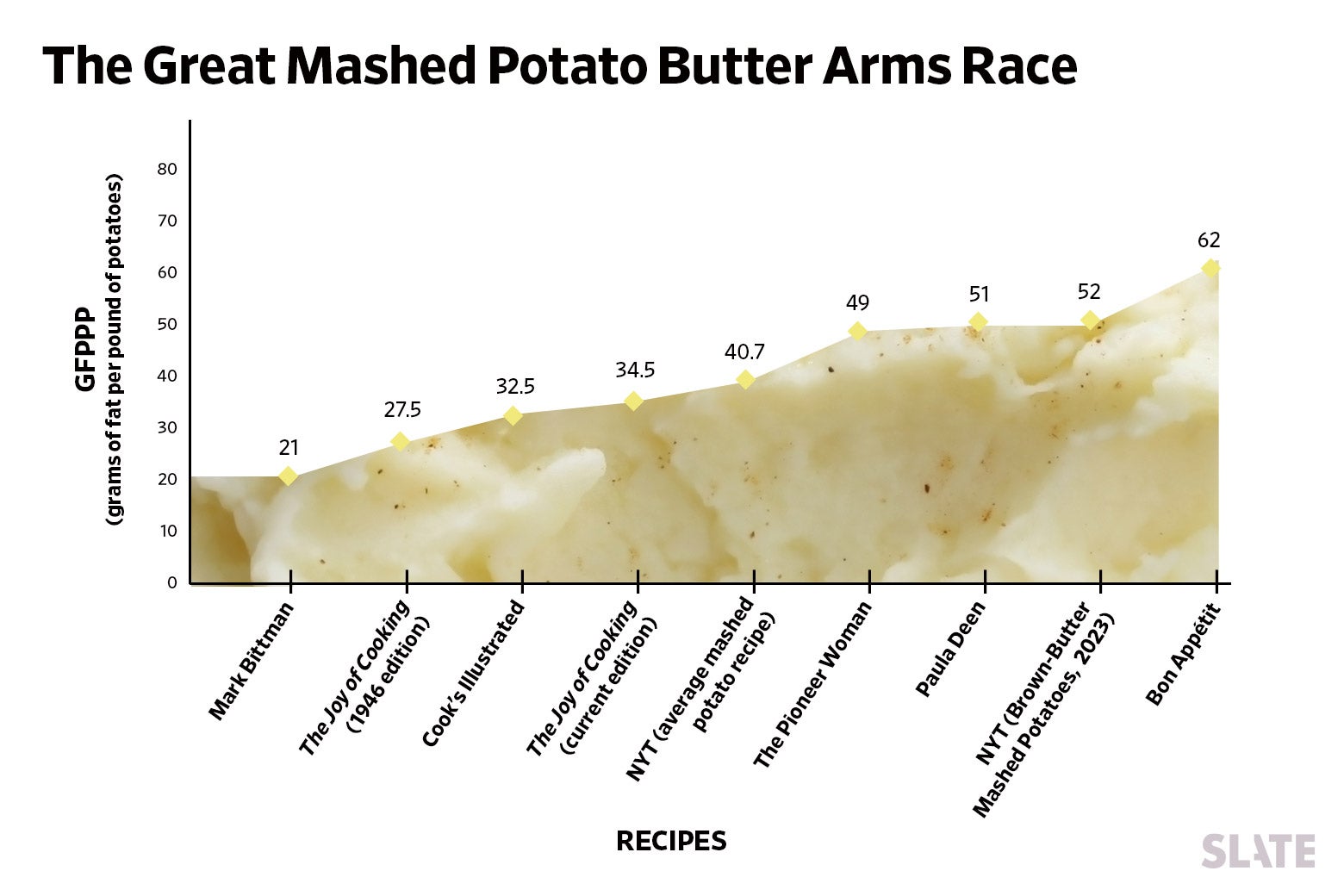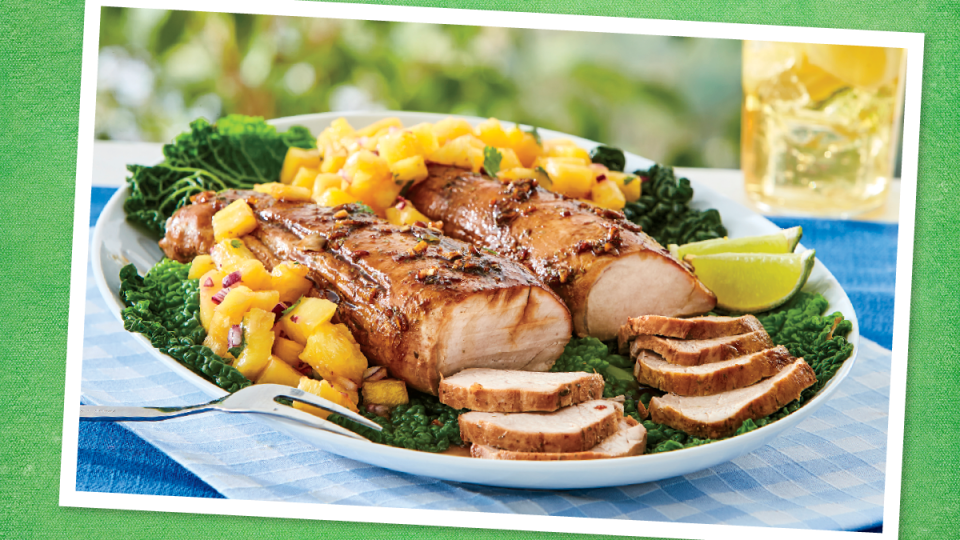What is the secret to great mashed potatoes? Some recipe writers will tell you it’s cream cheese, or ranch dressing, or garlic. Perhaps buttermilk is the key, or salt and vinegar? A Reddit thread titled “What’s the secret to the best mashed potatoes” yields suggestions of mayonnaise, crushed potato chips, English mustard, and Parmesan cheese—on top of such now–standard operating procedures as choosing the right potatoes, letting the cooked spuds dry in a colander or a warm pot, and using a ricer rather than a masher.
This month’s issue of Bon Appétit collects a number of the magazine’s holiday-season “greatest hits,” and pride of place goes to “The Best Mashed Potatoes We’ve Ever Made.” The recipe is “nonnegotiable” for Thanksgiving, the magazine claims, and “has legions of fans among staff and readers alike.” Indeed, these “impossibly smooth, once-a-year rich” potatoes are totally delicious: silky, fluffy, and deep in flavor. I loved them when I recently tried the recipe.
But what makes them so good? A closer look at the recipe, developed six years ago by then–Bon App editor Andy Baraghani, reveals the actual secret to mashed potatoes. It’s not any complicated cooking method, or any unusual ingredient. It’s fat. That’s it.
The Bon App recipe uses an incredible amount of butter, plus other added fats: To four pounds of potatoes (Yukon Golds, of course), Baraghani adds two full sticks of butter, 1 ½ cups of whole milk, and half a cup of heavy cream. While I recalled the various mashed-potato recipes I’ve used for past Thanksgivings being rich, I don’t remember them being quite this rich. A look back through my cookbooks confirmed it: Usually I add a stick of butter, max, and some buttermilk or a splash of cream.
Between the butter, cream, and milk, the Bon App spuds deliver an astounding 62 grams of fat per pound of potatoes (or GFPPP, a statistic I just now invented). In contrast, the potatoes I made last year, from Mark Bittman’s How to Cook Everything (3 tablespoons butter, ¾ cup milk), delivered only 21 GFPPP. And yeah, hey, big surprise—they didn’t taste as good.
Indeed, I found it difficult to locate any mashed-potato recipes as luxurious as Baraghani’s. Cooks Illustrated? 32.5 GFPPP. The Pioneer Woman, who tells you to add an entire package of cream cheese to your potatoes? 49 GFPPP. Even Paula freakin’ Deen couldn’t match the fat content of Bon App’s potatoes, rolling in with a mere 51 GFPPP. I did find evidence that as American tastes have gotten more decadent, mashed-potato recipes have followed—or perhaps led the way. The 1946 Joy of Cooking (3 tablespoons butter, ⅓ cup cream) is a relatively lean 27.5 GFPPP. The modern edition adds more cream, bringing its total to 34.5 GFPPP. While the New York Times features many, many recipes for mashed potatoes (average: 40.7 GFPPP), a notable new one appeared on the site earlier this month: Vaughn Vreeland’s Brown-Butter Mashed Potatoes, a recipe which foregrounds butter more than most, finishing with a drizzle of the golden, nutty liquid. It’s a valiant attempt to keep up in the unctuous arms race overtaking American potatoes, at a hearty 52 GFPPP.


Could it be true that the only thing that matters in mashed potatoes is fat? Could I have avoided all those years trying a million different flavor hacks (Rosemary simmered in milk! Raw onions! Fried garlic!) and just, like, added butter and cream to my potatoes until they simply couldn’t take it any more? It was time to talk to the expert.
When I asked former Bon Appétit editor Baraghani, whose first book, The Cook You Want to Be, recently won a James Beard Award, what his goal had been in developing his mashed-potato recipe, he thought back. “I was reading so many recipes promising no-lump mashed potatoes, or fluffy mashed potatoes,” he finally said. “I thought that people need to experience the joy of very, very buttery, creamy, French brasserie–style potatoes.” He was thinking of chefs like Jean-Georges Vongerichten and Daniel Boulud, he recalled. “And I knew the trick to that was the tremendous amount of butter, more than usual.”
Was it safe to say, I asked, that really, it doesn’t matter what you do to mashed potatoes—that if you add enough butter, they’ll be good? “Well, and I would argue a good amount of salt,” he noted. “The truth is, a potato is definitely a harder item to fuck up. It’s hard to have a bad potato.” Home cooks, he said, feel a lot of needless anxiety about the dish—Will mine be gummy? What about the peel?—but the truth is, it’s not that tricky to make good mashed potatoes. But, he added, “I don’t think my goal was to just make a good potato dish. I like to think that this is a restaurant-quality potato dish for a home cook.”
Did Baraghani think he had reached the absolute ultimate level of buttery mashed potatoes, or were there new horizons in fat infusion that some chef of the future was yet to reach? “I would say this recipe is pushing the limit. And while you certainly can add more butter, there is a point where you’re just tasting fat, and there is less of a balance in the dish. So it’s not that you can’t—it’s that I wouldn’t recommend it.”
I decided to put Baraghani’s recommendation to the test. I made the Bon App recipe, but this time divided the riced potatoes into three separate bowls: one to which I added the recipe-correct amount of butter, one with half as much butter, and one with twice as much butter. Of course, I topped each bowl with the final, extra pat of butter that the recipe, hilariously, recommends.


The difference in consistency was noticeable: The “low-butter” bowl (which, I must stress, still contained an insane amount of butter) was thick and a tiny bit lumpy, while the “high-butter” bowl had the consistency of grits, or the little pool of potato purée onto which a fancy restaurant would set a $27 order of short ribs. I brought in my taste-testers and asked them to try all three.
First off, we all agreed that they all tasted great. But my daughter, 16, preferred the fattiest version. “The texture of the others is better, but this one just tastes really, really good.” My wife preferred the “low-butter” version. “Texture is important,” she said. “That one over there is like baby food.” And me? I thought the recipe-standard potatoes were the best. I agreed with Baraghani that when you added more butter, soon all you tasted was butter—which is, as my daughter noted, really, really good, but maybe not what you want in a dish that is, ostensibly, potatoes. It seems possible to me that there is an upper limit to the amount of fat that mashed potatoes can accommodate—and Andy Baraghani, a genius, has found it.
However, Baraghani is not fixing his Bon App potatoes this year. “Maybe this is blasphemous, but that is not my favorite mashed potato recipe I’ve developed,” he confided. Instead, he’s making a more recent recipe that uses cream, butter, and labneh, plus fried garlic and dill. (Don’t worry—it may sound a little fussy, but it still comes in at an impressive 58 GFPPP.)
So even the man who mastered mashed potatoes is still tinkering. It’s easy to see why we’re always trying to improve the mashed potato. For what are potatoes, anyway? Merely wads of starch wrapped up in a peel. Mostly they are a vehicle for other flavors and textures: the sharp satisfaction of salt, the shattering crispiness of an oil-fried chip, the ketchup into which you dip your fries, or the butter that activates primal pleasure centers in our brains. There’s always some other flavor we want to try, that we think will finally give us something new and transcendent in an otherwise simple dish.
But me, I’m sticking with what I’ve learned on this journey. Because what the potato itself offers is pure comfort—the satisfying feeling of a warm, fatty foodstuff filling every nook and cranny of your stomach, as blown-in insulation fills a wall. It’s the perfect food for Thanksgiving, a holiday that is about fullness most of all—not only a full belly but a full table and a full heart.
So you want to make the best mashed potatoes your family has ever tasted this Thanksgiving? Great news. You don’t need any special techniques or ingredients. You just need butter. Throw square after square of butter into those potatoes, until the potatoes beg for mercy. Are you worried you used too much? Add a little more. Mix in some cream, too. And when you’re all done, top the whole thing with one last pat. Why not? A long, cold winter awaits.
from "recipes" - Google News https://ift.tt/clTB5H9
via IFTTT

No comments:
Post a Comment